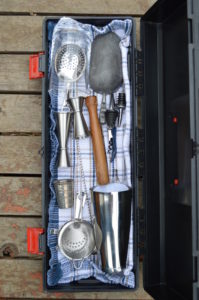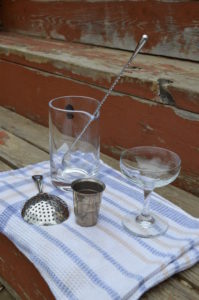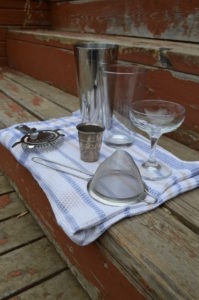 We often describe cocktails as “mixed drinks”. In this post we will discuss the two main ways we mix drinks -stirring, and shaking – and the equipment required for each.
We often describe cocktails as “mixed drinks”. In this post we will discuss the two main ways we mix drinks -stirring, and shaking – and the equipment required for each.
Before diving in, two important points on consistency: the dry build, and accurate measures.
Dry Build
- Whether shaking or stirring, best practice is to “dry build” your drink, that is, combine all of the liquid ingredients together before adding any ice.
- This is a technique from professional bars where consistency is paramount. The idea is that you want total control over the time that your drink spends on ice, so that you control the dilution and the final concentration of the drink.
- If you were to put ice in the glass, pour your spirit, then take time to juice your citrus, the dilution and chilling process has already started, and variances in how long it takes you to assemble and pour the other ingredients will affect your final drink.
Measures
- And speaking of consistency, accurate measuring is important.
- Classic hour-glass jigger.
- “Japanese jiggers” – you will often see fancy bartenders using jiggers that are strikingly taller and more slender than the classic North American jigger. These are called Japanese jiggers. They are designed for a more consistent pour. Say you consitently pour to within 2-4 mm from the top of a jigger. The narrower the mouth of the jigger, the smaller your variation in pour volume will be.
- Quick pour spouts
Why Cocktails are Mixed with Ice
With the exception of hot cocktails like Irish coffee, when we mix cocktails we are always mixing them with ice. Mixing with ice actually does several things:
- combines the ingredients (duh),
- chills the ingredients (also duh),
- dilutes the drink, and
- develops texture.
Combining and chilling are pretty obvious, but the dilution and texture developed by the ice and mixing technique are extremely important, often making the difference between an okay cocktail and an exceptional one.
Dilution
- If you’ve ever wondered why bartenders don’t just keep all their ingredients in the fridge and bypass the whole shaking/stirring with ice step, this is why: classic cocktail recipes account for the dilution of their ingredients caused by the melting ice. (Also there is the sheer joyous pageantry of mixing a drink in front of a guest.)
- For instance, if you make a classic Manhattan with 2 oz rye and 1 oz sweet vermouth, if you stir the drink properly, you end up with around 4 fl oz of liquid: you’ve added a whole ounce of water! This makes a huge difference in the final drink.
Mixing Methods: Shaking vs. Stirring
There are two main ways to mix a cocktail: shaking and stirring. James Bond’s famous drink order suggests that whether you do one or the other is a matter of personal taste. Most of the bartending world would disagree. There are cocktails that are meant to be shaken, and cocktails that are meant to be stirred (a martini, for the record, should be stirred…)
So, how do you know which should be shaken and which should be stirred?
Rule of Thumb: When to Shake and When to Stir
- drinks made entirely of spirits are stirred
- eg. Old Fashioned, Manhattan, Martini, Negroni
- drinks that contain juice, egg white, or cream are shaken
- eg. Sidecar, Margarita, Dacquiri, Brandy Alexander, Whiskey Sour
Stirred Cocktails

Bartenders usually stir drinks that are comprised entirely of spiritous liquids, ie. no citrus juice, no egg white, no cream.
The goal when stirring is to produce a frigidly cold drink, completely crystal clear, without any ice shards or air bubbles.
Stirring sounds moronically simple, but there are a few very important not-so-intuitive details that elevate stirred drinks to the next level.
Equipment
- Mixing Glass – There are standard mixing glasses that look a bit like a large beaker. You can really use any vessel you like, but the advantages of the glass beaker style are:
- They are heavy enough that they will stay in position on the counter as you stir.
- They are large enough to accommodate the copious ice required for proper chilling and dilution
- They are glass so that the customer can see the drink being stirred (pageantry)
- Barspoon
- Long spoons help your stir without moving your hands too much
- Julep Strainer – To hold back the ice as the drink is poured into the serving glass.
Standard Stirring Procedure
- Dry build cocktail in mixing glass.
- Fill the glass 3/4 full of ice. Yes, this seems like a lot but it is important! As the ice begins to melt the ice level will fall. Having a large matrix of ice from wall to wall and above the liquid level actually helps you stir rapidly.
- Stir smoothly and rapidly for 30-45 seconds. Yes, this seems like an unnaturally long period of time, but it is important!
- Strain the drink through julep strainer.
- Garnish as required.
Manhattan
Ingredients
- 2 oz Bulleit Rye
- 1 oz Carpano Antica Vermouth
- 1 dash Angostura Bitters
- orange zest
Procedure
- Follow standard stirring procedure described above.
- Pour drink into a chilled 4 oz coupe.
- Garnish with orange zest.
Shaken Cocktails

For drinks that contain citrus, egg white, or dairy.
The goal in shaking is again a frigidly cold drink with a full, almost airy, frosty texture, but still without shards of ice.
Equipment
- Shaker – The two main types of shaker are the Boston shaker and the cobbler shaker.
- Boston Shaker – This is the iconic mixing … glass and tin.
- Cobbler – This is a shaker with three parts: one that looks like the tin from a Boston shaker, a fitted top that has a pour spout with perforations that hold back ice, and a cap that closes the pour spout.
- Hawthorne strainer – Used to hold back large pieces of ice when pouring the drink from a Boston shaker.
- Fine mesh strainer – When a cocktail is being shaken the ice is shooting back and forth, slamming against one wall and then another within. This produces many small shards of ice that are not welcome in the final drink. The Hawthorne strainer holds back the bulk of the ice, but a fine mesh strainer is required to get the finer bits.
Method
- dry build
- fill shaker FULL of ice
- shake 12-15 seconds
- strain through Hawthorne and fine mesh
- garnish
Sidecar
Ingredients
- 2 oz Cognac
- 1 oz Cointreau
- 3/4 oz fresh lemon juice
- splash simple syrup
Procedure
- Follow standard shaking procedure as described above.
- Strain drink into chilled 6 oz coupe.
- Garnish with lemon zest.
Variations
Now, there are a handful of very important drinks that are not mixed with these methods. The Old Fashioned and Planter’s Punch are both “built drinks” that are made directly in the glass they are served. Many other classics use slight variations on the techniques described above. For instance bubbly ingredients like sparkling wine or soda would never be shaken or stirred as it would destroy the effervescence. When making a French 75, the gin, syrup, and lemon juice are shaken in the manner described above, then poured into the Champagne flute, and then the Champagne is poured on top.
And of course there are drinks that employ muddling, and “frozen” (slushy) drinks and hot drinks like Irish coffee. I’m hoping these will be discussed in future posts. However, by learning the simple mechanics of standard stirring and shaking you will be capable of mixing the vast majority of cocktails, both classic and new-fangled.